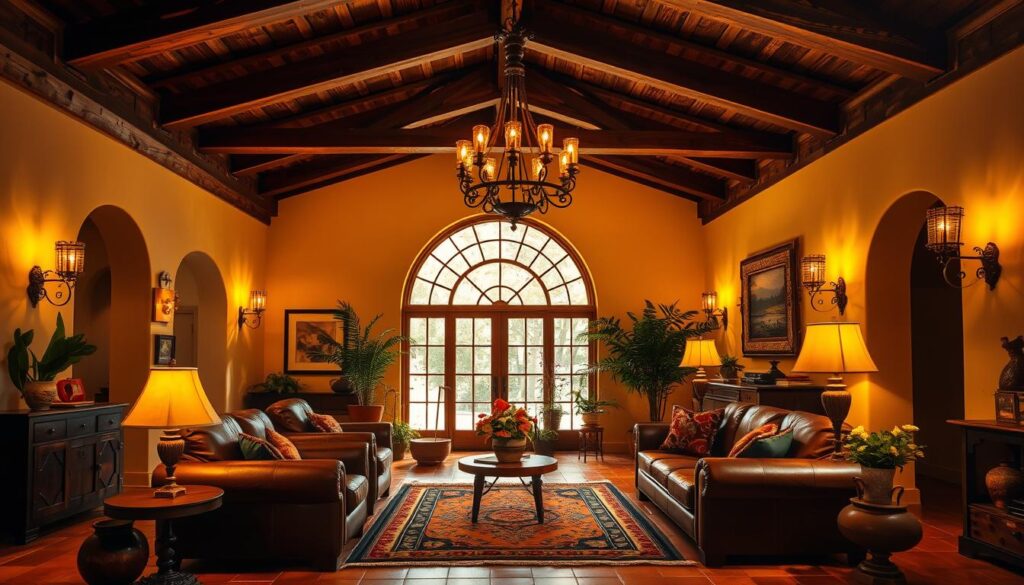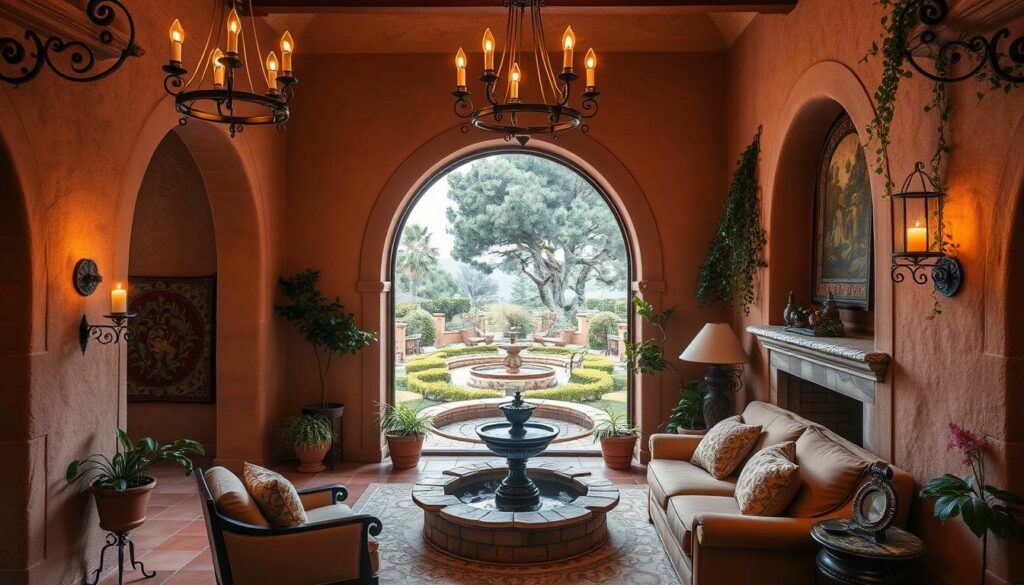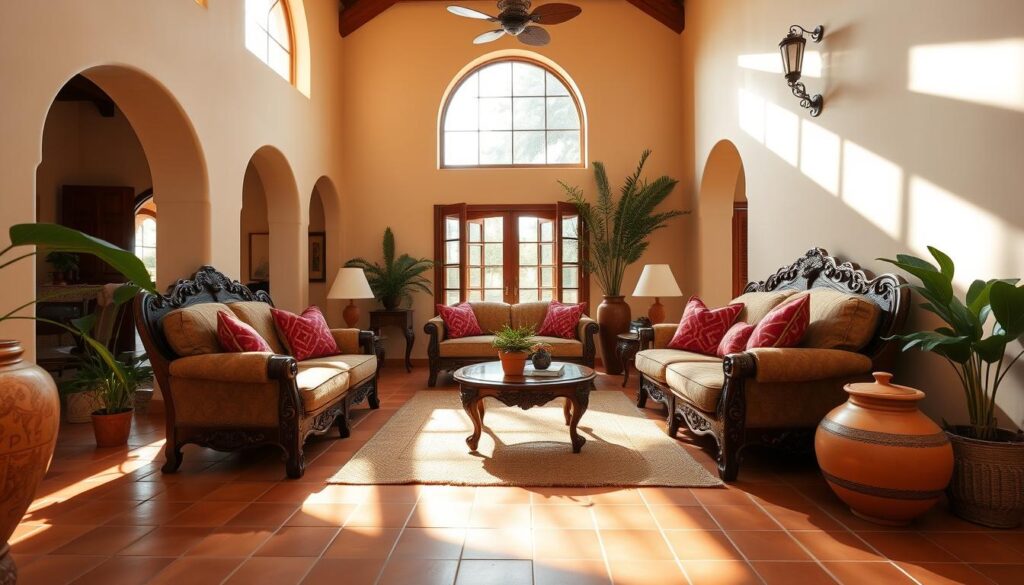Did you know Spanish-style homes have become very popular in the last ten years? This style is known for its warm and welcoming look. It has won the hearts of many homeowners in the United States.
We will look into how you can make your home more beautiful with this timeless design. Spanish-style interior design mixes old charm with modern touches. It’s a unique way to decorate your space.
By choosing this style, you can make your home feel cozy and inviting. It shows off your personal style.
Key Takeaways
- Understand the core elements of Spanish-style interior design
- Learn how to incorporate traditional Spanish features into your home
- Discover tips for balancing rustic and modern elements
- Create a warm and inviting atmosphere with Spanish-inspired decor
- Elevate your home’s aesthetic with our expert advice
Understanding Spanish-Style Homes Interior Design
To truly understand Spanish-style interior design, we must first explore its historical roots and the architectural influences that have shaped it.
The Origins and History of Spanish Architecture
Spanish architecture has a rich and diverse history. It was influenced by cultures like the Moors, Romans, and Goths. This mix of styles is seen in the country’s interior design, with arches, columns, and ornate details.
The Spanish Colonial period’s architectural style has greatly influenced interior design. It includes heavy wooden doors, wrought iron fixtures, and handcrafted tiles.
Key Characteristics of Spanish-Style Interiors
Spanish-style interiors are warm and inviting. They use earthy tones, rich textiles, and natural materials. Some key characteristics include:
- Arches and curved lines, adding a sense of fluidity and elegance
- Ornate details, such as intricate woodwork and hand-painted tiles
- Wrought iron fixtures, used for lighting, railings, and other decorative elements
- Rich textiles, including wool, silk, and linen, used for upholstery and drapery
| Characteristic | Description | Example |
|---|---|---|
| Arches and Curved Lines | Adds a sense of fluidity and elegance | Arched doorways, curved staircases |
| Ornate Details | Intricate woodwork, hand-painted tiles | Carved wooden furniture, decorative tiles |
| Wrought Iron Fixtures | Used for lighting, railings, decorative elements | Wrought iron chandeliers, railings |
By understanding the historical context and key characteristics of Spanish-style interiors, we can better appreciate the elements that make up this unique and captivating design style.
Essential Color Palettes for Spanish Homes
To capture the essence of Spanish colonial style, it’s key to pick a color palette that reflects warmth and richness. The right colors can take you to Spain’s historic landscapes, making your home cozy and inviting.
Warm Tones and Earthy Hues
Spanish-style homes are known for their warm tones and earthy hues, evoking the Spanish countryside. Colors like terracotta, sienna, and golden brown bring the warmth of the Spanish sun. Soft creams and beiges balance these bold colors.
Terracotta is a key color in Spanish colonial decor, often used for flooring and accent tiles. It adds a deep, rich warmth to any room. Sienna and golden brown hues are used in woodwork, furniture, and wall finishes for a cohesive look.
“The use of terracotta and earthy tones in Spanish homes not only adds warmth but also connects the indoor spaces to the natural landscape outside.”
Accent Colors for Bold Statements
While warm tones and earthy hues are the base, accent colors add depth and character. Deep blues, vibrant greens, and rich yellows are used to make bold statements in Spanish-style homes.
- Deep Blues: Often used in tiles, pottery, and textiles, deep blues add elegance and sophistication.
- Vibrant Greens: Used in furniture upholstery and decorative accessories, vibrant greens bring a lively, festive feel.
- Rich Yellows: This sunny color is perfect for adding a pop of color through artwork, rugs, or accent walls.
By thoughtfully incorporating these accent colors, homeowners can add layers of visual interest and personality to their Spanish-style homes. This makes each space truly unique.
Choosing the Right Furniture for Spanish Interiors
Spanish revival interiors are rich in history and culture. The furniture you pick is key to bringing this style to life. It not only makes your home look great but also feels warm and welcoming.
When picking furniture for your Spanish-style home, knowing the traditional styles is crucial. Traditional Spanish furniture often features dark woods, detailed carvings, and fancy metalwork.
Traditional Spanish Furniture Styles
Traditional Spanish furniture reflects the country’s history and culture. Some key features include:
- Dark, rich woods like mahogany and walnut
- Intricate carvings and ornate details
- Wrought iron accents and metalwork
- Comfortable, plush upholstery with vibrant textiles
These elements create a warm, inviting atmosphere that’s truly Spanish. Adding these traditional pieces brings depth and authenticity to your Spanish revival interiors.
Incorporating Modern Pieces
While traditional furniture is essential for Spanish-style interiors, modern pieces can also be great. The goal is to mix old and new, blending traditional elegance with modern simplicity.
For instance, pair a traditional Spanish-style sofa with modern, sleek coffee tables or accent chairs. This mix adds visual interest and makes your space feel both timeless and modern.
By carefully combining traditional and modern furniture, you can create a Spanish revival interior that’s both beautiful and practical. It reflects your personal style while honoring Spanish design’s rich heritage.
Decorative Elements That Define Spanish Home Interiors
To get a hacienda style interior, adding traditional Spanish decor is essential. These elements make the home look elegant and inviting. They also bring history and culture into our homes.
Wrought iron fixtures and accessories are a big part of Spanish home decor. They add elegance and sophistication to any room.
Wrought Iron Fixtures and Accessories
Wrought iron is a key part of Spanish decor, used in lights, railings, and more. It’s durable and versatile, perfect for both inside and outside. Adding wrought iron elements can make our living spaces feel more traditional and welcoming.
Handcrafted Tiles and Textiles
Handcrafted tiles and textiles are also vital in Spanish home decor. They often have detailed designs that share stories of Spanish culture. Adding these elements can make our homes unique and full of character, reflecting the hacienda style.
By mixing these decorative elements, we can create a warm and inviting space. It honors Spanish tradition while also being our own.
The Importance of Textures in Spanish Design
In Spanish-style homes, textures are key, not just an extra. They add depth, warmth, and interest. This makes the room feel welcoming and real.
Textures are vital for a rich atmosphere in Spanish interiors. Mixing materials and finishes creates a unique look. This look shows the warmth and hospitality of Spanish culture.
Incorporating Natural Materials
Using natural materials is a great way to add texture. Wood, stone, and clay are favorites. They make the space feel warm and genuine. Wooden beams and stone floors add a rustic feel. Clay tiles bring a sense of earthiness.
For a modern twist, check out our guide to designing a colonial home. It shows how to mix old and new styles.
Layering Textures for Depth
Layering textures makes a space interesting and dynamic. Mixing smooth and rough textures creates a balanced look. For example, smooth leather with a wooden coffee table is striking.
To add more texture, use woven baskets, embroidered fabrics, and patterned rugs. These add warmth and coziness to the space.
By using natural materials and layering textures, you can make a Spanish-style interior that’s both stunning and inviting.
Lighting Solutions for Spanish-Style Homes
Lighting is crucial in Spanish-style homes, making them warm and welcoming. The right lights highlight the beauty of Spanish architecture and create a cozy feel.
Traditional Lighting Fixtures
Traditional Spanish lighting often uses wrought iron for elegance. Chandeliers, sconces, and pendant lights made of wrought iron are favorites. They light up the space and add to the home’s cultural charm.
Lantern-style lighting is another classic choice. These lanterns, made from metal or ceramic, hang from ceilings or sit on walls. They bring a warm light and show off Spanish craftsmanship.
| Fixture Type | Material | Characteristics |
|---|---|---|
| Wrought Iron Chandeliers | Wrought Iron | Elegant, sophisticated, decorative |
| Lantern-Style Lighting | Metal, Ceramic | Warm glow, traditional, cultural |
| Pendant Lights | Wrought Iron, Glass | Versatile, stylish, ambient |
Modern Lighting Ideas with Spanish Flair
Modern lighting can also fit into Spanish homes, adding a new twist. Modern pendant lights with a Spanish touch can update the look. They mix traditional materials like wrought iron with modern designs.
Layered lighting is another modern idea. It combines different lights for a cozy atmosphere. This includes overhead lights, table lamps, and floor lamps, all chosen to match the Spanish decor.

By mixing old and new lighting, homes can have a unique and appealing feel. Whether you like the classic look of wrought iron or modern designs, there’s a lighting option for everyone.
Outdoor Spaces: Bringing Spanish Style Outside
Spanish style isn’t just for inside; it shines in outdoor spaces too. Courtyards, patios, and gardens are key parts of Spanish homes. They extend the living area, adding warmth and elegance.
Courtyards and Patios
Courtyards and patios are vital in Spanish homes. They offer peaceful spots that mix indoor and outdoor living. These areas often feature wrought iron fixtures and handcrafted tiles, matching the home’s decor.
To make a welcoming courtyard or patio, use natural materials like stone and wood. Add lush plants like olive trees or bougainvillea. Earthy tones and bright colors help blend indoor and outdoor spaces smoothly.
Garden Design Influences
Garden design in Spanish homes draws from Mediterranean and Spanish Colonial styles. These gardens mix plants, herbs, and trees for peace and a natural feel.
Key garden design elements include:
- Choosing drought-resistant plants from the Mediterranean
- Adding water features like fountains or ponds
- Using terracotta pots and urns for color and texture
- Creating paths with natural stone or brick
| Design Element | Description | Example |
|---|---|---|
| Water Features | Adds a soothing element to the garden | Fountains, small ponds |
| Terracotta Pots | Brings warmth and color to the garden | Urns, planters |
| Natural Pathways | Creates a sense of journey through the garden | Stone, brick pathways |
By adding these elements, you can make an outdoor space that matches your Spanish-style home. It becomes a beautiful, functional area for relaxation and fun.
Tips for Personalizing Your Spanish-Style Interior
To make your Spanish-style home special, add personal touches that show your cultural heritage. Use family heirlooms, cultural artifacts, or traditional Spanish elements that mean a lot to you.
Infusing Cultural Heritage
Adding personal touches to your Spanish revival interiors can be done by including cultural heritage elements. This includes:
- Displaying family heirlooms, such as antique furniture or handmade textiles.
- Incorporating traditional Spanish artwork, like paintings or sculptures.
- Using cultural artifacts, such as vintage ceramics or handmade tiles, as decorative pieces.
These elements help create a space that shows your cultural heritage and tells a story.
Mixing Contemporary and Traditional Styles
To make your hacienda style interiors unique and welcoming, mix contemporary and traditional styles. You can do this by:
- Pairing traditional Spanish furniture with modern pieces.
- Incorporating contemporary artwork or decorative pieces alongside traditional elements.
- Using modern materials, like glass or steel, alongside traditional materials, like wood or stone.

The secret to personalizing your Spanish-style interior is finding a balance. Mix traditional elements with your unique style. This way, you create a space that is both beautiful and meaningful.
Maintenance and Care for Spanish-Style Interiors
To keep your Spanish-style home looking great, regular upkeep is key. Check and clean stucco walls and terracotta roof tiles often. This helps them stay in good shape. For homes with Talavera tiles, cleaning and sealing them keeps their colors and patterns bright.
Upkeep Best Practices
Regular cleaning, pest control, and seasonal upkeep stop debris from building up. Sweep courtyards, trim plants, clean fountains, and tighten loose tiles often. Dusting and cleaning furniture, and fixing scratches quickly, also helps.
Protecting Unique Features
Wrought iron details and dark hardwood pieces need special care. Clean wrought iron to avoid rust. For more tips on keeping your Spanish-style home beautiful, check out A House in the Hills. They share ways to preserve your home’s rustic charm.


